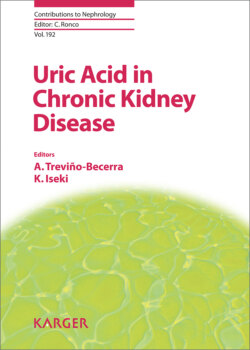Читать книгу Uric Acid in Chronic Kidney Disease - Группа авторов - Страница 14
На сайте Литреса книга снята с продажи.
Uric Acid Basis
ОглавлениеIn some mammalian species and other living organisms, uric acid is usually a product of the metabolic breakdown in purine metabolism. Uricase or urate oxidase usually oxidizes to allantoin, a highly hydrolyzed product that is afterwards excreted in urine. Humans have a nonfunctional urate oxidase because of which protein drug formulations do benefit in certain pathological conditions [2].
Humans are not able to oxidize uric acid due to its lack of urate oxidase activity, so the liver is in charge of involving some enzymatic reactions to convert the 2 purine nucleic acids, adenine and guanine, to uric acid. Initially, guanine monophosphate, adenosine monophosphate and inosine monophosphate are converted to nucleosides, inosine and guanosine, and further converted to a purine base, hypoxanthine and guanine, which undergoes chemical processes to form xanthine. Finally, xanthine is oxidized by xanthine oxidase to form uric acid Figure 1.
Fig. 1. Oxidation of xanthine by xanthine oxidase to form uric acid.
